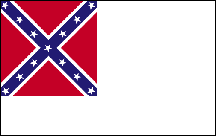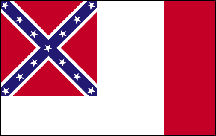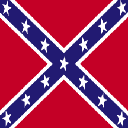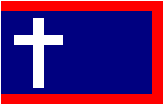
Flags of the Confederacy

The First National Flag also known as the "Stars and Bars" was adopted March 4, 1861, by the Confederate Congress. Like some of the early state flags, the 1st National looked similar to the "Stars and Stripes". It was designed by Nicola Marschall of Alabama. The flag had three equal horizontal bars: red, white, and red. When it was first adopted, the blue canton consisted of seven stars in a circle, symbolizing the first seven states of the Confederacy: South Carolina, Mississippi, Alabama, Louisiana, Georgia, Florida, and Texas. By July of 1861, four more stars were added due to the secession of Virginia, Arkansas, North Carolina, and Tennessee to make eleven total. By the end of 1861 Kentucky and Missouri were admitted, bringing the total number of states to thirteen. The stars were not always sewn into a circle; sometimes other patterns were used to make the flag unique. Coats of arms, mottoes, unit designations, and battles were often added as well.

The Second National Flag was adopted in May of 1863, because the 1st National looked too similar to the Stars and Stripes and was hard to distinguish between the two amidst the smoke and confusion on the battlefield. This flag was nicknamed "The Jackson Flag" because it was first officially used to cover the casket of Thomas J. "Stonewall" Jackson at his funeral. It is commonly known as the "Stainless Banner" because of the plain white field. The flag's red canton was crossed by a white-edged, blue saltire, also known as the Saint Andrew's Cross, holding thirteen white stars, symbolizing the thirteen states of the Confederacy. The canton resembled the Confederate Battle Flag that had been used in the Eastern Theater since 1861. This design was abandoned because in calm weather, the flag looked like a flag of truce.

The Third National Flag was adopted in March of 1865. The Confederate Congress changed the flag's proportions and added a red vertical bar to the fly end. Only a few of the 3rd National were made before the surrender at Appomattox. The red bar now symbolizes the blood shed by Confederate veterans.

The Confederate Battle Flag was adopted in 1861 to avoid confusion on the battlefield because the 1st National looked so much like the Stars and Stripes. General P.G.T. Beauregard proposed that the design of William Porcher Miles had submitted as a national flag be adopted as the Confederate battle flag. Miles designed a rectangular red field crossed with a blue saltire, also known as the Saint Andrew's Cross, holding seven white stars, symbolizing the seven states of the Confederacy at that time. The flag was adopted after making it square to save material, and a boarder was added to limit wear.

The Missouri Battle Flag was distinctly associated with the Trans-Mississippi Department. It was carried almost exclusively by Missouri regiments, becoming identified as the "Missouri Battle Flag". It is a blue flag bordered with red, and a white Roman cross in the field near the hoist of the flag.

The Missouri State Guard Flag was never formally adopted as the official state flag in Missouri legislation. The flag was adopted in Missouri by direction of General Sterling Price of the Missouri State Guard. When orders were issued in the Spring of 1861 for district commanders of the State Guard to prepare their troops for active duty, they were instructed that each regiment: "was to carry a Missouri flag, made of blue merino, with the state arms in gold on both sides".
Information about these flags were found in the following sources:
"Echoes of Glory: Arms & Equipment of the Confederacy", Time-Life Books
"Flags of the Confederacy", Devereaux D. Cannon, Jr.
http://www.livingston.net/aks/
"Bonnie Blue Flag" sequenced by Dayle K.